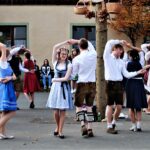
Folk traditions help you learn about different cultures. Our village celebrated Kirwa (kir-vah) this past weekend, a uniquely Bavarian tradition. So I decided to see if I could describe it to someone who had never attended one. At a glance, it looks like a miniature Oktoberfest with bratwurst and beer, singing and dancing.
Initially, they celebrated Kirwa to honor the consecration of the village church, which was done on the name day of the saint for which the church was named. In our case, Saint Wolfgang. Later, the villages moved their celebrations to the Sunday closest to that date.
The Catholic church frowned on this secular activity which brought about much partying, and in 1866, issued the decree that Kirwa could only be celebrated on the third Sunday of October. The villages here in the Oberpfalz, and some in Franconia, gave a resounding, “No, I don’t think so.” People not only celebrate their own village Kirwa but also attend the surrounding villages’ festivals throughout the year. And the tradition continues. There are over 100 held in the Oberpfalz between April and November.

After setting up on Friday night, with much celebration, this weekend-long festival of eating, drinking, and dancing begins on Saturday when the young men go out into the forest early in the morning to cut down the largest tree they can find. This tree should be over 30 meters, but each village always brags that theirs is taller. The tree is brought into the town and decorated, usually by the young ladies of the village. They attach wreaths and ribbons while the young lads carve the village name and the year into the trunk.

No mechanical means are used to raise the tree, though it is held off the ground by a tractor while they decorate. The tree is raised using poles of varying lengths, known as swallows, pushing them upward, moving them, and repeating the process. Some villages now use mechanized means to raise the tree. However, our town is proud of the fact that they continue the old traditions. Once the tree is up, the party starts.
The grills are continuously lit until the wee hours. Trust me, they were still going at 3:30 am! Each region has its own formula for bratwurst. Maybe I’m biased, but I do like the Oberpfalz sausages.
 And beer flows freely, even for breakfast. However, I’m not one to give up my coffee quite that early. Special treats are baked for the occasion, and you can always get pretzels!
And beer flows freely, even for breakfast. However, I’m not one to give up my coffee quite that early. Special treats are baked for the occasion, and you can always get pretzels!
The people attend a church service on Sunday morning, followed by cake and coffee. In the afternoon, the village youth perform the ritual dances wearing the trachten, or traditional clothing, which consists of a dirndl, a jumper-style dress with an apron for the women and lederhosen for the men.
 Each village has its own dances. Some are very traditional, while others are performed in fun. They are accompanied by an accordion, a tuba, and a guitar. During the final dance, the couples pass a bouquet of flowers hand-to-hand. Each tries to pass it off quickly to the next, for the pair stuck with it when the music stops are named the King and Queen of the Kirwa. Only the organizer knows who will be chosen and will stop the music. But the musicians have some fun with it and throw in a quick pause or two to frighten the dancers. The prize? Organizing next year’s event.
Each village has its own dances. Some are very traditional, while others are performed in fun. They are accompanied by an accordion, a tuba, and a guitar. During the final dance, the couples pass a bouquet of flowers hand-to-hand. Each tries to pass it off quickly to the next, for the pair stuck with it when the music stops are named the King and Queen of the Kirwa. Only the organizer knows who will be chosen and will stop the music. But the musicians have some fun with it and throw in a quick pause or two to frighten the dancers. The prize? Organizing next year’s event.

Monday is a quiet day where families gather for more beer and bratwurst before the stand, tables, and chairs are packed away for next year. As we live facing the square, this occurs in our front yard. It is Widgit’s favorite time of year as he watches the festivities and enjoys a few bites of sausage. I’m convinced he went into mourning on Tuesday when it was only a memory until next year.
If you’d like to see more photos, see my facebook page at https://www.facebook.com/CarolAmorosiAuthor
